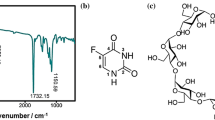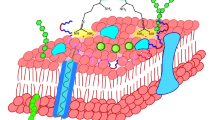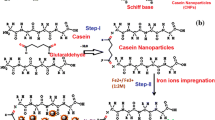Abstract
A novel and specific drug delivery for in vitro cancer targeted are developed successfully by a simple one-step method. A CoFe2O4@Methionine core–shell nanoparticle was prepared by the reflux assay which amino acid in the surface makes ferrite biocompatible, enhances its chemical stability, and improves the drug-loading capacity. The synthesized nanoparticles were characterized using FTIR, TGA, XRD, SEM, TEM, and VSM which coating amino acid on the surface of CoFe2O4 was confirmed by XRD and TGA. The appearance of a new peak for C≡N confirms the formation of Letrozole-loaded carrier in the FTIR. The vibrating sample magnetometer of both bare CoFe2O4 and Methionine-coated CoFe2O4 nanoparticles exhibited room-temperature superparamagnetic behavior with a saturation value of 46 emu/g and 16.8 emu/g, respectively. The morphology and size of samples were characterized by SEM and TEM that the average size of the particle was around 28–29 nm. The loading of Letrozole and the effect of pH (5, 7.4) on the release behavior of the carrier was studied. The result of the drug release in pH is equal to 5 was about 88% which higher than pH is equal to 7.4. Also, the preparation had been evaluated for determining its cytotoxicity using MCF-7, MDA-MB-231, and MCF10A cells as an in vitro model, and the result vitro experiments showed that CoFe2O4@Methionine could significantly reduce cancer in cells model. These results demonstrate that core–shell nanoparticle was prepared is biocompatible and have potential use as drug delivery.
Graphical abstract











Similar content being viewed by others
Data availability
Not applicable.
References
Anand V, Singh K, Kaur K, Bhatia G. Drug loaded silica coated MnFe2O4 ferromagnetic biomaterials for targeted cancer treatment. AIP Conference Proceedings. AIP Publishing LLC. 2017;p. 040009.
Anand V, Singh K, Kaur K. Evaluation of zinc and magnesium doped 45S5 mesoporous bioactive glass system for the growth of hydroxyl apatite layer. J Non-Crys Sol. 2014;406:88–94.
Lee DW, Barrett DM, Mackall C, Orentas R, Grupp SA. The future is now: chimeric antigen receptors as new targeted therapies for childhood cancer. AACR; 2012.
Vallet-Regí M, Ragel CV, Salinas AJ. Glasses with medical applications. Eur J Inorg Chem. 2003;2003:1029–42.
Vasir JK, Labhasetwar V. Targeted drug delivery in cancer therapy. Technol Cancer Res Treat. 2005;4:363–74.
Wang TW, Wu HC, Wang WR, Lin FH, Lou PJ, Shieh MJ, Young TH. The development of magnetic degradable DP-Bioglass for hyperthermia cancer therapy. J Biomed Mater Res A. 2007;83:828–37.
Gavas S, Quazi S, Karpiński TM. Nanoparticles for cancer therapy: current progress and challenges. Nanoscale Res Lett. 2021;16:173. https://doi.org/10.1186/s11671-021-03628-6.
Jemal A, Bray F, Center MM, Ferlay J, Ward E, Forman D. Global cancer statistics. CA: Cancer J Clinicians. 2011;61:69–90.
Quazi S. Vaccine in response to COVID-19: Recent developments, challenges, and a way out. Biomed Biotechnol Res J. 2021;5:105–9.
Quazi S. An overview Of CAR T cell mediated B cell maturation antigen therapy. Clin Lymphoma Myeloma Leuk. 2022;22(6):e392–404.
Quazi S. Artificial intelligence and machine learning in precision and genomic medicine. Med Oncol. 2022;39:120. https://doi.org/10.1007/s12032-022-01711-1.
Quazi S. Elucidation of CRISPR-Cas9 application in novel cellular immunotherapy. Mol Biol Rep. 2022;49:7069–77. https://doi.org/10.1007/s11033-022-07147-0.
Quazi S. Role of artificial intelligence and machine learning in bioinformatics: drug discovery and drug repurposing. Preprints 2021, 2021050346.
Smith IE. Letrozole versus tamoxifen in the treatment of advanced breast cancer and as neoadjuvant therapy. J Steroid Biochem Mol Biol. 2003;86:289–93.
Yue W, Wang J-P, Hamilton CJ, Demers LM, Santen RJ. In situ aromatization enhances breast tumor estradiol levels and cellular proliferation. Can Res. 1998;58:927–32.
Furet P, Batzl C, Bhatnagar A, Francotte E, Rihs G, Lang M. Aromatase inhibitors: synthesis, biological activity, and binding mode of azole-type compounds. J Med Chem. 1993;36:1393–400.
Lang M, Batzl C, Furet P, Bowman R, Häusler A, Bhatnagar A. Structure-activity relationships and binding model of novel aromatase inhibitors. J Steroid Biochem Mol Biol. 1993;44:421–8.
Mondal N, Pal T, Ghosal S. Development, physical characterization, micromeritics and in vitro release kinetics of letrozole loaded biodegradable nanoparticles. Die Pharmazie-Int J Pharma Sci. 2008;63:361–5.
Saboktakin MR, Tabatabaie RM, Maharramov A, Ramazanov MA. Synthesis and in vitro studies of biodegradable thiolated chitosan hydrogels for breast cancer therapy. Int J Biol Macromol. 2011;48:747–52.
Dey C, Baishya K, Ghosh A, Goswami MM, Ghosh A, Mandal K. Improvement of drug delivery by hyperthermia treatment using magnetic cubic cobalt ferrite nanoparticles. J Magn Magn Mater. 2017;427:168–74.
Dhal S, Mohanty A, Yadav I, Uvanesh K, Kulanthaivel S, Banerjee I, Pal K, Giri S. Magnetic nanoparticle incorporated oleogel as iontophoretic drug delivery system. Colloids Surf, B. 2017;157:118–29.
Ramasamy T, Ruttala HB, Gupta B, Poudel BK, Choi H-G, Yong CS, Kim JO. Smart chemistry-based nanosized drug delivery systems for systemic applications: a comprehensive review. J Control Release. 2017;258:226–53.
Zhao C, Liu X, Zhang X, Yan H, Qian Z, Li X, Ma Z, Han Q, Pei C. A facile one-step method for preparation of Fe3O4/CS/INH nanoparticles as a targeted drug delivery for tuberculosis. Mater Sci Eng, C. 2017;77:1182–8.
Goh S, Chia CH, Zakaria S, Yusoff M, Haw C, Ahmadi S, Huang N, Lim H. Hydrothermal preparation of high saturation magnetization and coercivity cobalt ferrite nanocrystals without subsequent calcination. Mater Chem Phys. 2010;120:31–5.
Sivakumar M, Kanagesan S, Babu RS, Jesurani S, Velmurugan R, Thirupathi C, Kalaivani T. Synthesis of CoFe 2 O 4 powder via PVA assisted sol–gel process. J Mater Sci: Mater Electron. 2012;23:1045–9.
Zhao L, Yang H, Zhao X, Yu L, Cui Y, Feng S. Magnetic properties of CoFe2O4 ferrite doped with rare earth ion. Mater Lett. 2006;60:1–6.
Sharma S, Kumar R, Gaur A. A model for magnetic nanoparticles transport in a channel for targeted drug delivery. Procedia Materials Science. 2015;10:44–9.
Ghorbani M, Hamishehkar H, Arsalani N, Entezami AA. Preparation of thermo and pH-responsive polymer@ Au/Fe 3 O 4 core/shell nanoparticles as a carrier for delivery of anticancer agent. J Nanopart Res. 2015;17:305.
Sundaresan V, Menon JU, Rahimi M, Nguyen KT, Wadajkar AS. Dual-responsive polymer-coated iron oxide nanoparticles for drug delivery and imaging applications. Int J Pharm. 2014;466:1–7.
Unsoy G, Khodadust R, Yalcin S, Mutlu P, Gunduz U. Synthesis of Doxorubicin loaded magnetic chitosan nanoparticles for pH responsive targeted drug delivery. Eur J Pharm Sci. 2014;62:243–50.
Fan H-L, Li L, Zhou S-F, Liu Y-Z. Continuous preparation of Fe3O4 nanoparticles combined with surface modification by L-cysteine and their application in heavy metal adsorption. Ceram Int. 2016;42:4228–37.
Wang Y, Xiao Y, Gao G, Chen J, Hou R, Wang Q, Liu L, Fu J. Conductive graphene oxide hydrogels reduced and bridged by l-cysteine to support cell adhesion and growth. J Mater Chem B. 2017;5:511–6.
Wang G, Zhou F, Li X, Li J, Ma Y, Mu J, Zhang Z, Che H, Zhang X. Controlled synthesis of L-cysteine coated cobalt ferrite nanoparticles for drug delivery. Ceram Int. 2018;44:13588–94.
Ghafelehbashi R, Akbarzadeh I, Yaraki MT, Lajevardi A, Fatemizadeh M, Saremi LH. Preparation, physicochemical properties, in vitro evaluation and release behavior of cephalexin-loaded niosomes. Int J Pharm. 2019;569:118580.
Akbarzadeh I, Yaraki MT, Bourbour M, Noorbazargan H, Lajevardi A, Shilsar SMS, Heidari F, Mousavian SM. Optimized doxycycline-loaded niosomal formulation for treatment of infection-associated prostate cancer: an in-vitro investigation. J Drug Deliv Sci Technol. 2020;57:101715.
Fatima Z, Quazi S, Gavas S, Karpiński T. Use of cerium nitrate nanoparticles in biological environment along with the factors effecting it: an empirical overview. Preprints 2021, 2021080537.
Quazi S, Jangi R, Gavas S, Karpinski T. Artificial intelligence and machine learning in medicinal chemistry and validation of emerging drug targets, in Advancements in Controlled Drug Delivery Systems (2022), pp. 27–43.
Acknowledgements
The manuscript was initially announced as a preprint at research square on December 3rd, 2021.
Funding
This research received no external funding.
Author information
Authors and Affiliations
Corresponding author
Ethics declarations
Conflict of interest
The authors declare no conflict of interest.
Informed consent
Not applicable.
Institutional review board
Not applicable.
Additional information
Publisher's Note
Springer Nature remains neutral with regard to jurisdictional claims in published maps and institutional affiliations.
Rights and permissions
Springer Nature or its licensor holds exclusive rights to this article under a publishing agreement with the author(s) or other rightsholder(s); author self-archiving of the accepted manuscript version of this article is solely governed by the terms of such publishing agreement and applicable law.
About this article
Cite this article
Eshrati Yeganeh, F., Eshrati Yeganeh, A., Fatemizadeh, M. et al. In vitro cytotoxicity and anti-cancer drug release behavior of methionine-coated magnetite nanoparticles as carriers. Med Oncol 39, 252 (2022). https://doi.org/10.1007/s12032-022-01838-1
Received:
Accepted:
Published:
DOI: https://doi.org/10.1007/s12032-022-01838-1




